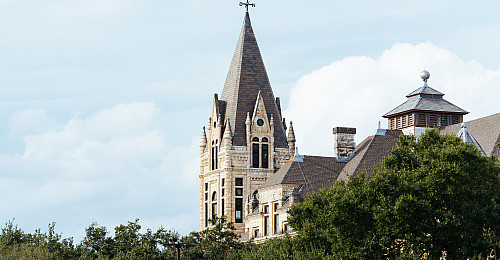
- mcarthuk@southwestern.edu
- 512.863.1830
- Fondren-Jones 207
- http://klmcarthurphd.com

Led by dedicated faculty, top-notch career services, and a vibrant campus community, Southwestern University has again earned recognition as one of the top institutions in the country.
more information
Professor of Communication Studies Bob Bednar led five students deep into the Houston Methodist Hospital system to analyze organizational communication at one of the nation’s leading healthcare systems.
more information
As perspectives surrounding higher education shift, Southwestern University is doubling down on the impact and value of a liberal arts education.
more information
Since the launch of the Thrive campaign in 2018, the Southwestern community has donated over $160 million to elevate student success, enhance academic excellence, and transform the campus.
more information
In the true spirit of Paideia, physics and computer science students put their heads together to complete two different research objectives.
more information
Learn more about the legacy of Southwestern University’s first female registrar through a series of letters between Pearl Alma Neas, Lyndon Baines Johnson, and Lady Bird Johnson.
more information
Nationwide education services company honors Southwestern University as a 2025 “Best Value College.”
more information
SU recognized as one of the top student-centered undergraduate universities in the nation, anchored by strong career development, business, and education programs.
more information
Incoming students and families had their first chance to experience life at Southwestern during Sprog orientation sessions this summer.
more information
A pair of first-year biochemistry majors designed their own experiment aimed at increasing certain chemical compounds produced by spinach plants using different types of fertilizers.
more information
Led by dedicated faculty, top-notch career services, and a vibrant campus community, Southwestern University has again earned recognition as one of the top institutions in the country.
more information
Professor of Communication Studies Bob Bednar led five students deep into the Houston Methodist Hospital system to analyze organizational communication at one of the nation’s leading healthcare systems.
more information
As perspectives surrounding higher education shift, Southwestern University is doubling down on the impact and value of a liberal arts education.
more information
Since the launch of the Thrive campaign in 2018, the Southwestern community has donated over $160 million to elevate student success, enhance academic excellence, and transform the campus.
more information
In the true spirit of Paideia, physics and computer science students put their heads together to complete two different research objectives.
more information
Learn more about the legacy of Southwestern University’s first female registrar through a series of letters between Pearl Alma Neas, Lyndon Baines Johnson, and Lady Bird Johnson.
more information
Nationwide education services company honors Southwestern University as a 2025 “Best Value College.”
more information
SU recognized as one of the top student-centered undergraduate universities in the nation, anchored by strong career development, business, and education programs.
more information
Incoming students and families had their first chance to experience life at Southwestern during Sprog orientation sessions this summer.
more information
A pair of first-year biochemistry majors designed their own experiment aimed at increasing certain chemical compounds produced by spinach plants using different types of fertilizers.
more information
Led by dedicated faculty, top-notch career services, and a vibrant campus community, Southwestern University has again earned recognition as one of the top institutions in the country.
more information
Professor of Communication Studies Bob Bednar led five students deep into the Houston Methodist Hospital system to analyze organizational communication at one of the nation’s leading healthcare systems.
more information
As perspectives surrounding higher education shift, Southwestern University is doubling down on the impact and value of a liberal arts education.
more information
Since the launch of the Thrive campaign in 2018, the Southwestern community has donated over $160 million to elevate student success, enhance academic excellence, and transform the campus.
more information
In the true spirit of Paideia, physics and computer science students put their heads together to complete two different research objectives.
more information
Nationwide education services company honors Southwestern University as a 2025 “Best Value College.”
more information
SU recognized as one of the top student-centered undergraduate universities in the nation, anchored by strong career development, business, and education programs.
more information
Incoming students and families had their first chance to experience life at Southwestern during Sprog orientation sessions this summer.
more information
A pair of first-year biochemistry majors designed their own experiment aimed at increasing certain chemical compounds produced by spinach plants using different types of fertilizers.
more information
Trustee Brent Austin has encouraged the Southwestern community to match his $500,000 gift and push the University closer to reaching its fundraising goal for the new facility.
more information
Led by dedicated faculty, top-notch career services, and a vibrant campus community, Southwestern University has again earned recognition as one of the top institutions in the country.
more information
Professor of Communication Studies Bob Bednar led five students deep into the Houston Methodist Hospital system to analyze organizational communication at one of the nation’s leading healthcare systems.
more information
As perspectives surrounding higher education shift, Southwestern University is doubling down on the impact and value of a liberal arts education.
more information
Since the launch of the Thrive campaign in 2018, the Southwestern community has donated over $160 million to elevate student success, enhance academic excellence, and transform the campus.
more information
In the true spirit of Paideia, physics and computer science students put their heads together to complete two different research objectives.
more information
Learn more about the legacy of Southwestern University’s first female registrar through a series of letters between Pearl Alma Neas, Lyndon Baines Johnson, and Lady Bird Johnson.
more information
Nationwide education services company honors Southwestern University as a 2025 “Best Value College.”
more information
SU recognized as one of the top student-centered undergraduate universities in the nation, anchored by strong career development, business, and education programs.
more information
Incoming students and families had their first chance to experience life at Southwestern during Sprog orientation sessions this summer.
more information
A pair of first-year biochemistry majors designed their own experiment aimed at increasing certain chemical compounds produced by spinach plants using different types of fertilizers.
more information
Led by dedicated faculty, top-notch career services, and a vibrant campus community, Southwestern University has again earned recognition as one of the top institutions in the country.
more information
Professor of Communication Studies Bob Bednar led five students deep into the Houston Methodist Hospital system to analyze organizational communication at one of the nation’s leading healthcare systems.
more information
As perspectives surrounding higher education shift, Southwestern University is doubling down on the impact and value of a liberal arts education.
more information
Since the launch of the Thrive campaign in 2018, the Southwestern community has donated over $160 million to elevate student success, enhance academic excellence, and transform the campus.
more information
In the true spirit of Paideia, physics and computer science students put their heads together to complete two different research objectives.
more information
Learn more about the legacy of Southwestern University’s first female registrar through a series of letters between Pearl Alma Neas, Lyndon Baines Johnson, and Lady Bird Johnson.
more information
Nationwide education services company honors Southwestern University as a 2025 “Best Value College.”
more information
SU recognized as one of the top student-centered undergraduate universities in the nation, anchored by strong career development, business, and education programs.
more information
Trustee Brent Austin has encouraged the Southwestern community to match his $500,000 gift and push the University closer to reaching its fundraising goal for the new facility.
more information
By embracing the support system on campus and the resources available through Southwestern’s liberal arts education, first-generation student Fernando Cruz-Rivera ’26 has put himself on track to a successful career in government.
more information
The weekend of February 28 – March 2 brought scientists from all over Texas to McLennan Community College and Baylor University in Waco, for the 145th Texas Academy of Sciences meeting. Ten students represented the Biology Department, including Gage Mallo ’26, Johun Reyes ’26, Annika Tracy ’25, Murphy Jacobie ’27, Madeleine Thomas ’26, Kylie Allemeier ’26, Katelin Pilarski ’26, Sarah Berver ’26, Alanna Guerrero ’25 and Jordan Emerson ’27.
Based on her collaboration with Assistant Professor of Biology Kim McArthur, Annika gave a talk, titled “Location-independent axon pathfinding in the hindbrain of larval zebrafish,” that earned the first place undergraduate talk award for the neuroscience section.
Madeleine presented a poster with her research mentor, Assistant Professor of Biology Sunny Scobell, titled “A morphological analysis of the dopaminergic pathway in the brain of a male pregnant pipefish.” Dr. Scobell also mentored Jennifer Smalz, a student from her previous institution (UD: The University of Dallas), who gave a talk titled “Investigating male pregnancy in Gulf Pipefish using scanning electron microscopy to describe the anatomy of the brood pouch over the reproductive cycle.” Ms. Smalz’ talk earned the first place undergraduate award in the systematics and evolutionary biology section. Within that section, Dr. Scobell also gave two presentations, one co-authored with UD student Farah Atarah, titled “Brood pouch anatomy throughout the course of male pregnancy in Gulf Pipefish,” and another focusing on her endocrinology, titled an “Investigation of the role of prolactin during reproduction in a fish with male pregnancy.”
Murphie presented a microbiology focused poster, titled “An affinity analysis of Aliivibrio fischeri and zooxanthellae” with the mentorship of Director of First Year Biology Laboratories Stacie Brown.
Working with Chair and Garey Professor of Biology Romi Burks, Gage presented a poster, titled “You better Belize they’re different: Phylogenetic analysis and species identification of native apple snails in Belize,” that garnered a first place best poster award in the systematics and evolutionary biology section. His poster co-author Johun secured first place in the Undergraduate Research Award Competition, complete with a $2,000 prize to continue the work, with his proposal, “Beneath Belizean waters: Discovering diversity of native apple snails in northern and southern Belize.”
Also from the Burks lab, Kylie, Sarah, and Katelin shared their recent troubleshooting efforts in the lab in a poster titled “Extraordinary extraction efforts: Experiments to enhance DNA extraction for tissues of apple snails of conservation interests” that also used collections from Belize that occurred as part of the 2024 study abroad experience.
Dr. Burks also gave an oral presentation in the science education section about the recent undergraduate research experience that she developed in BIO50-222, Methods in Ecology and Evolution. Her talk, titled “Methodological microplastics: Development of an undergraduate CURE to quantify abundance of microplastic fibers in a local stream,” came out of conversations with microplastics expert Andre Felton from the University of Texas at San Antonio.
Assistant Professor of Biology Kim McArthur authored a spotlight article recently accepted in the journal Trends in Neurosciences. The article, titled “Cranial motor neuron input specificity refined by activity,” provides a critical analysis of a recent primary research article in her area of expertise (Kaneko et al. 2024, “Position-independent functional refinement within the vagus motor topographic map”). The spotlight and research article both address the “big picture” question of how motor neurons in the vertebrate hindbrain receive appropriate synaptic inputs during early motor circuit development.
Assistant Professor of Biology Kim McArthur co-authored a research article recently accepted in the Journal of Comparative Neurology, presenting the results of her Spring 2023 sabbatical (funded, in part, by the Sam Taylor Fellowship). The article, titled “Structure and topography of facial branchiomotor neuron dendrites in larval zebrafish (Danio rerio),” uses a combination of single-cell labeling, in vivo fluorescence microscopic imaging, and 3D tracing to provide evidence that early synaptic input to motor neurons may be determined by the relative location of their dendrites in the developing hindbrain. This work contributes to our growing understanding of the importance of early spatial organization for the development of neural circuits.
Assistant Professor of Biology Kim McArthur presented a virtual poster at the annual meeting of the Society for Neuroscience in November 2023. Her poster, titled “Mapping the dendrite topography of facial motor neurons in larval zebrafish,” presented preliminary results from her sabbatical research, gathering evidence to test the hypothesis that the relative positioning of a neuron’s dendrites can determine which synaptic inputs that neuron receives– thereby determining its functional role in a neural circuit.
—January 2024Assistant Professor of Biology Kim McArthur, with co-authors Emma Astad ’21, Emmett Griffin-Baldwin ’22, Bria Tovar ’22, and Tori Tovar ’22, wrote a research article recently accepted in the Journal of Comparative Neurology. The article, entitled “Early development of respiratory motor circuits in larval zebrafish (Danio rerio),” uses a combination of behavioral analysis and functional calcium imaging to reveal the developmental time course of early synaptic inputs from respiratory, central pattern-generating circuits to the cranial motor neurons that generate coordinated breathing behaviors. This work provides critical foundational information about the development of an emerging model circuit in developmental neurobiology, setting the stage for future work probing the mechanisms of synapse development.
—February 2023